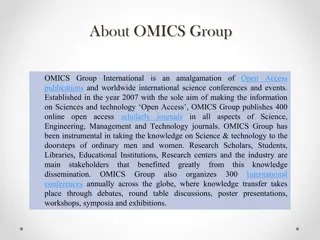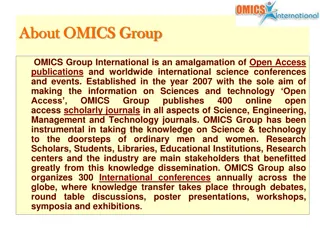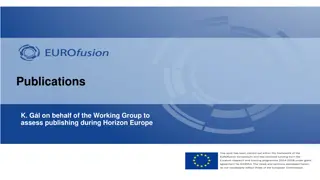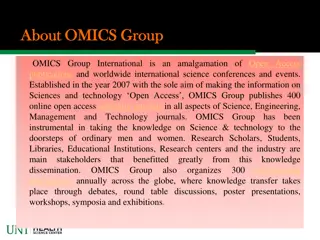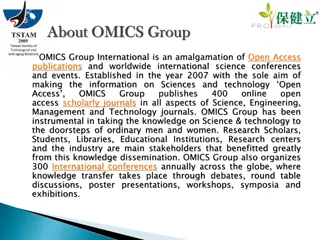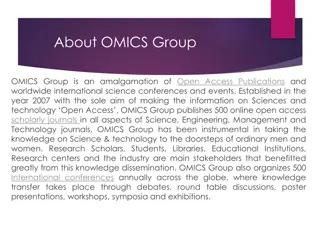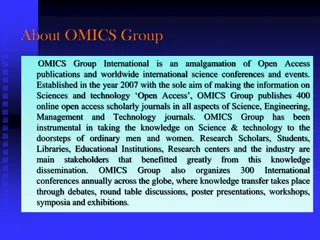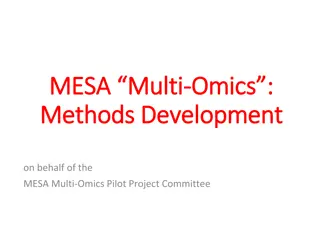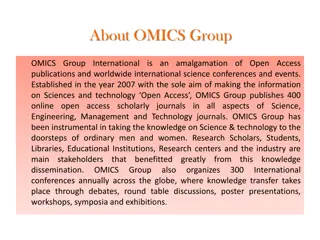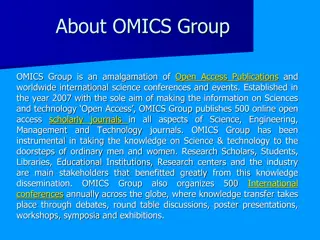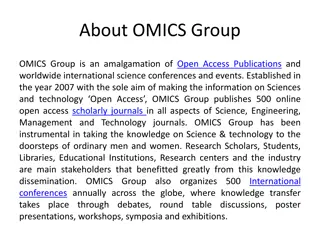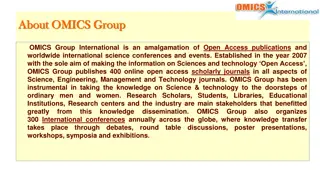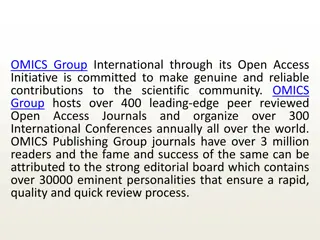OMICS Group: Open Access Science Journals and Conferences
OMICS Group International, established in 2007, is a leading publisher of 400 online open access scholarly journals covering a wide range of Science, Engineering, Management, and Technology disciplines. They also organize 300 international conferences annually, facilitating knowledge transfer through debates, workshops, and more. The content discusses topics like localised thermal desorption for extracting volatile hydrocarbons and the cost and causes of fire-related incidents in Australia and the United States. Conviction rates for arson are low due to challenges in securing evidence from fire scenes.
Download Presentation

Please find below an Image/Link to download the presentation.
The content on the website is provided AS IS for your information and personal use only. It may not be sold, licensed, or shared on other websites without obtaining consent from the author.If you encounter any issues during the download, it is possible that the publisher has removed the file from their server.
You are allowed to download the files provided on this website for personal or commercial use, subject to the condition that they are used lawfully. All files are the property of their respective owners.
The content on the website is provided AS IS for your information and personal use only. It may not be sold, licensed, or shared on other websites without obtaining consent from the author.
E N D
Presentation Transcript
About OMICS Group About OMICS Group OMICS Group International is an amalgamation of Open Access publications and worldwide international science conferences and events. Established in the year 2007 with the sole aim of making the information on Sciences and technology Open Access , OMICS Group publishes 400 online open access scholarly journals in all aspects of Science, Engineering, Management and Technology journals. OMICS Group has been instrumental in taking the knowledge on Science & technology to the doorsteps of ordinary men and women. Research Scholars, Students, Libraries, Educational Institutions, Research centers and the industry are main stakeholders that benefitted greatly from this knowledge dissemination. OMICS Group also organizes 300 International conferences annually across the globe, where knowledge transfer takes place through debates, round table discussions, poster presentations, exhibitions. workshops, symposia and
About OMICS Group Conferences About OMICS Group Conferences OMICS Group International is a pioneer and leading science event organizer, which publishes around 400 open access journals and conducts over 300 Medical, Clinical, Engineering, Life Sciences, Phrama scientific conferences all over the globe annually with the support of more than 1000 scientific associations and 30,000 editorial board members and 3.5 million followers to its credit. OMICS Group has organized 500 conferences, workshops and national symposiums across the major cities including San Francisco, Las Vegas, San Antonio, Omaha, Orlando, Raleigh, Santa Clara, Chicago, Philadelphia, Baltimore, United Kingdom, Valencia, Dubai, Beijing, Hyderabad, Bengaluruand Mumbai.
The Use of Localised Thermal Desorption for Extraction of Volatile Hydrocarbons fromwithin a Fire Scene: A Multi-Study Analysis Tom Smale, Bsci(Psy), BFor
The Cost of Fire In Australia, the average cost of damages caused by bush fires per year is AUD$80-100 million [1] The cost of arson-related fires in the United States was US$551 million in 2010 [2] There are over 100 fire-related deaths and 3,000 fire-related injuries in Australia each year [3]
Causes of Fire In Australia Arson Accidental/Act of Nature
Evidence and Fire Scenes Conviction rates for arson are exceedingly low 9% for Australia [4] 5% for the United States [5] This is partly due to the nature of fire scene evidence The presence of an accelerant in a scene indicates a likelihood of deliberate fire-setting Unfortunately the accelerants used in arson are mostly consumed in the fire itself However, small amounts of accelerant can still be present within a scene post-burn
Collecting Trace Accelerants Trace amounts of liquid accelerants, known as Ignitable Liquid Residue (ILR), can remain on surfaces and debris within the scene This ILR is a valuable source of evidence as it can be extracted and analysed using Gas Chromatography Mass Spectrometry (GC-MS) Specialised extraction techniques must be used to remove the ILR from debris or surfaces
The Challenge Most extraction techniques require the substrate be moved to a laboratory for testing However, ILR may be present on large, fixed surfaces within a scene, such as concrete It can be impractical or unsafe to try and remove sections of these fixed surfaces for transport and laboratory-based analysis
Extraction Methods Numerous methods are possible, including distillation and dichloromethane rinsing A common method involves thermal desorption The sample is heated in a container, evaporating the ILR from the substrate The evaporated ILR forms a gaseous cloud in the top of the container, known as a headspace This headspace can be sampled using either activated charcoal or a solid-phase microextraction needle
Research at CIT has focused on finding a way to perform these procedures directly at the scene
Recent Research at CIT Recent research has focused on using thermal desorption as a scene-based technique, rather than a lab-based technique This has led to the creation of the Passive Headspace Residue Extraction Device (P.H.R.E.D.), designed to generate heat in a contained section of substrate via infrared radiation
P.H.R.E.D. (Passive Headspace Residue Extraction Device) Image courtesy of Canberra Institute of Technology
How P.H.R.E.D. Works Image courtesy of CIT
Research 2011-2012 The first PHRED was constructed and used to sample E10 Petroleum Distillate from a fixed concrete surface Collection was via activated charcoal with a subsequent dichloromethane (DCM) wash to extract the ILR compounds The DCM wash was then analysed via GC-MS The presence of petroleum ILR was indicated by the GC-MS detection of specific ASTM standard compounds used to identify petroleum [6] The relative abundance of several of these compounds was later used to compare the sensitivity of PHRED to other techniques
Target Compounds for Petrol Toluene 1,2,3-Trimelthybenzene Ethyl-benzene Indene m-Xylene 1,3-Diethylbenzene p- Xylene 1-Methyl-3-Propylbenzene o- Xylene 1,4-Diethylbenzene Propyl-benzene 4-Ethyl-1,3-dimethylbenzene 1-Ethyl-3-Methylbenzene 4-Ethyl-1,2-dimethylbenzene 1-Ethyl-4-Methylbenzene 2-Ethyl-1,3-dimethylbenzene 1,3,5-Trimethylbenzene 1,2,4,5-Tetramethylbenzene 1-Ethyl-2-Methylbenzene 1,2,3,5-Tetramethylbenzene 1,2,4-Trimethylbenzene Naphthalene 2-Methylnaphthalene 1-Methynaphthalene
Target Compounds for Petrol Toluene 1,2,3-Trimelthybenzene Ethyl-benzene Indene m-Xylene 1,3-Diethylbenzene p- Xylene 1-Methyl-3-Propylbenzene o- Xylene 1,4-Diethylbenzene Propyl-benzene 4-Ethyl-1,3-dimethylbenzene 1-Ethyl-3-Methylbenzene 4-Ethyl-1,2-dimethylbenzene 1-Ethyl-4-Methylbenzene 2-Ethyl-1,3-dimethylbenzene 1,3,5-Trimethylbenzene 1,2,4,5-Tetramethylbenzene 1-Ethyl-2-Methylbenzene 1,2,3,5-Tetramethylbenzene 1,2,4-Trimethylbenzene Naphthalene 2-Methylnaphthalene 1-Methynaphthalene Denotes compounds used for comparisons
2011-2012 PHRED on Concrete Target Compound Average Relative Abundance Toluene 72,000 units Xylene 39,000 units Ethyl-benzene 39,000 units
2013 The PHRED technique was used to extract kerosene samples from a concrete surface PHRED was used against an alternative technique: The loaded concrete surface was washed with boiling water, which was then retrieved via sponging the surface The water was later analysed using a Solid-Phase Microextraction needle Results indicated this washing technique was more sensitive than the activated-charcoal-based PHRED technique [7]
2013 PHRED vs Boiling Water Rinse Target Compound PHRED Boiling Water Naphthalene 9,000 units 9,000 units Dodecane 10,500 units 100,000 units
2014 The PHRED technique was modified SPME sampling from the headspace was used instead of activated charcoal
Analysis of Results- Petroleum 1,200,000 1,000,000 800,000 600,000 Xylene Benzene 400,000 Toluene 200,000 0 PHRED with Charcoal PHRED with SPME Hot Water with Charcoal Hot Water with SPME The results show a much higher degree of sensitivity for PHRED in conjunction with SPME than with charcoal
Conclusions Localised thermal desorption was effective in retrieving volatile hydrocarbons from both E10 petroleum distillate and kerosene-covered substrates Results indicate that the PHRED technique benefits greatly from the use of a SPME needle The use of a hot water rinse is a viable alternative The sensitivity of both techniques differs depending on the particular type of accelerant and the use of charcoal versus SPME
Future Research Research is currently continuing to compare PHRED-SPME to other field-based extraction techniques, such as diatomaceous earth Combining the PHRED technique with a portable GC-MS would completely remove the necessity for a laboratory stage. Research is needed to determine the efficacy of this technique The use of localised thermal desorption has not yet been applied to samples which have undergone heavy weathering or uncontrolled burning Use of the PHRED in an authentic fire scene could provide data that would further develop the device
Acknowledgements Canberra Institute of Technology Staff (past and present), especially Dr. Kym Turnbull, Dr. Isaac Arthur, Dr. Robert Berthon, Michaela Popham, Lavanya Kumarappan, Robert Ferguson, Russell Stuart, Greg Carnell, Lloyd Pieper, Peter Warne and David Royds, Yvonne Van Der Meer and Genevieve Williams Canberra Institute of Technology Forensic Research Project students- Sarah Higgins, Louise Shields, Amy McMahon, Alexander Visotin and Amber Chalker The National Centre for Forensic Studies
References [1] Australian Institute of Criminology (AIC) 2004. The cost of bushfires. Bushfire arson bulletin no. 2. http://www.aic.gov.au/publications/current%20series/bfab/1- 20/bfab002.aspx [2] United States Fire Administration, 2010, Residential Arson Facts, http://www.usfa.fema.gov/fireservice/prevention_education/ strategies/arson/aaw13/facts.shtm [3] Ashe, B. & McAneney, J., 2012, The Real Cost of Fire in Australia , World Fire Statistics Bulletin, no. 28
References [4] Australian Bureau of Statistics 2007, Sentences for arson in Victoria, Bushfire Arson Bulletin no. 41 [5] Bush, A.M. 2009, Arson Difficult to Prosecute , The Topeka Capital-Journal [6] American Society for Testing and Materials (ASTM), Standard ASTM-E 1618-01 (Standard Test Method for Ignitable Liquid Extracts by Gas Chromatograph-Mss Spectrometry) [7] Higgins, S. (2013), Comparison of Effectiveness in the Extraction of Gasoline Residues using Hot Water, SPME and PHRED, Canberra Institute of Technology
Let Us Meet Again Let Us Meet Again We welcome you all to our future conferences of OMICS Group International Please Visit: www.omicsgroup.com www.conferenceseries.com










